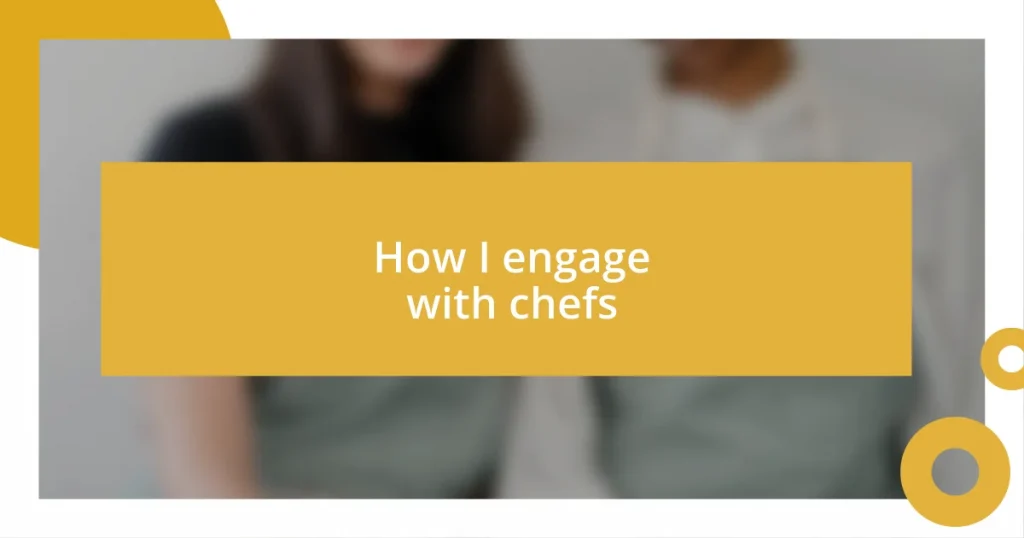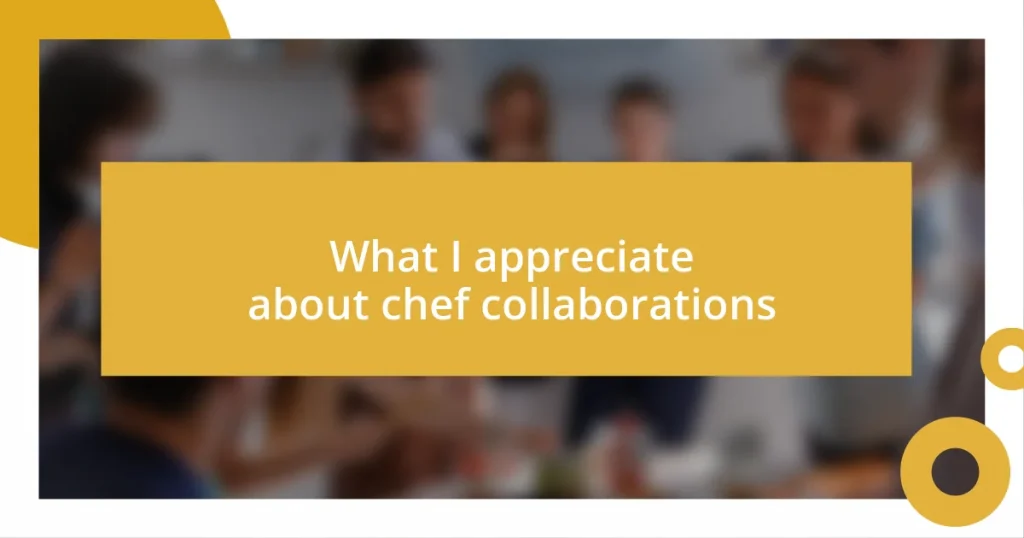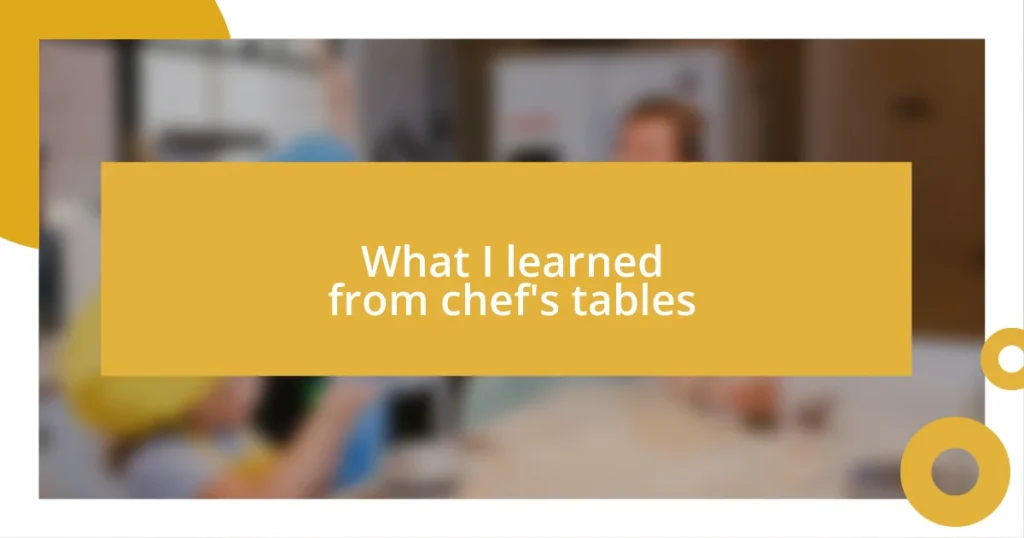Key takeaways:
- Engaging with chefs involves recognizing their passion and creativity, fostering personal connections through meaningful dialogue and shared experiences.
- Building relationships with chefs requires regular interaction, such as attending their events, offering constructive feedback, and showing genuine support for their initiatives.
- Effective communication, including active listening and adapting to a chef’s personality, enhances rapport and deepens the culinary experience for both parties involved.

Understanding chef engagement strategies
Engaging with chefs involves understanding their unique passion for their craft. I’ve often found that when I take the time to ask about their inspirations, the conversation shifts from mere pleasantries to a genuine exchange. Have you ever noticed how chefs light up when discussing their favorite ingredients or culinary techniques? This kind of dialogue fosters a deeper connection.
In my experience, recognizing a chef’s hard work and dedication can significantly enhance our interactions. I remember one occasion when a chef shared the stress of a busy Saturday night service. Just acknowledging that pressure and expressing gratitude for their effort turned our conversation into something very personal and meaningful. It made me realize how much chefs appreciate being seen not just as food creators, but as dedicated artisans.
Furthermore, I’ve learned that participating in collaborative events, like pop-up dinners or community food festivals, creates an incredible bonding opportunity. When I joined a culinary event with local chefs, the shared laughter and creative energy transformed casual acquaintances into lasting friendships. Isn’t it fascinating how food can bring people together and create unforgettable moments?

Building relationships with chefs
Building relationships with chefs goes beyond just appreciating their food; it’s about cultivating a personal connection. I vividly recall a simple yet profound moment where I invited a chef to discuss his culinary journey over coffee. Our chat quickly evolved from mundane small talk to an exploration of his childhood memories tied to flavors and family recipes. It was in that intimate setting I realized that sharing experiences can create an emotional bond, which is essential for fostering trust.
Here are some practical ways to build those relationships with chefs:
– Attend Cooking Classes: Participating in classes led by chefs allows for hands-on learning and personal interaction.
– Frequent Their Establishments: Regular visits can create familiarity and show genuine interest in their work.
– Engage on Social Media: Commenting on their posts or sharing your experiences directly connects you to their creative process.
– Provide Constructive Feedback: Chefs appreciate thoughtful insights on their dishes; it opens a dialogue based on respect and collaboration.
– Support Their Initiatives: Whether it’s a charity event or a new dish feature, showing support speaks volumes about your commitment to their craft.
These approaches not only make engagement more meaningful but also build a network of support that benefits both chefs and food enthusiasts like me.

Effective communication with chefs
Effective communication with chefs is crucial for fostering strong relationships and enhancing our collective culinary experiences. I find that using a blend of open-ended questions and active listening works wonders. When I approach a chef during a quiet moment in the kitchen, expressing sincere curiosity about their latest dish often leads to insightful conversations. For example, one time, I asked a chef about the story behind their signature sauce, and the passion they exhibited was palpable. It felt like I was part of a narrative that extended beyond just flavors on a plate.
I also believe that non-verbal cues play an essential role in effective communication. A simple nod of understanding or maintaining eye contact makes a significant impact. During one evening in a bustling restaurant, I noticed how a chef responded positively to my enthusiastic thumbs-up after tasting their dish. It was a small gesture, but it communicated appreciation and encouraged them to share more about their cooking philosophy. This kind of interactive feedback creates a two-way street where chefs feel valued and motivated to engage further.
Furthermore, I’ve discovered that tailoring my communication style to match the chef’s personality enhances rapport. For instance, some chefs thrive on humor and quick banter, while others appreciate a more serious discussion about culinary trends. I recall a delightful exchange with a jovial chef who loved cracking jokes while demonstrating his unique plating techniques. That light-hearted interaction made our learning experience memorable. Understanding these nuances has transformed my approach to communicating with chefs, allowing for richer, more meaningful dialogues.
| Aspect | Effective Communication Strategies |
|---|---|
| Questioning | Ask open-ended questions to encourage detailed responses. |
| Active Listening | Demonstrate engagement through active listening and body language. |
| Feedback | Provide both verbal and non-verbal feedback to foster interaction. |
| Personalization | Adapt your communication style to suit the chef’s personality. |

Collaborating on menu development
Collaborating on menu development is a thrilling experience that truly allows me to dive deep into the chef’s creative process. I remember a day when I sat down with a talented chef who was experimenting with seasonal ingredients. As we tasted various dishes, I felt a surge of excitement discussing how each element complemented one another. It struck me how much chefs appreciate collaborators who contribute ideas rather than just critique. Have you ever brainstormed menu ideas with a chef? If you have, you know how invigorating it can be to watch their eyes light up at a new concept.
In one memorable instance, we focused on integrating local produce into the menu. As we discussed the possibilities, I suggested incorporating heirloom tomatoes into a summer salad, recalling my experiences with them in my backyard garden. The chef smiled and shared stories of their own childhood summer nights spent at markets, crafting dishes with fresh ingredients. This shared inspiration not only strengthened our working relationship but also made the menu feel alive with stories and connections. Doesn’t it feel rewarding to contribute to something that has deep roots, literally and figuratively?
I’ve come to realize that the most successful collaborations often stem from a genuine desire to explore and innovate. During one collaboration, we experimented with fusions of culture, blending traditional techniques with modern flavors. The dish that emerged, a spicy miso ramen topped with crispy pork belly, was not only a testament to our teamwork but also a reflection of our passion. Engaging in the creative process together makes you feel like you’re crafting a piece of art side by side. Have you ever felt that creative spark when working with someone on a shared vision? It’s a sensation I cherish, and it keeps me coming back for more.

Gathering feedback from chefs
Gathering feedback from chefs can be as enriching as it is informative. I remember one evening when I sought a chef’s thoughts after a dinner service. I asked them to share their reflections on what worked and what needed tweaking. Their candid comments not only shed light on the intricacies of their dishes but also revealed the pride they took in refining their craft. Have you ever noticed how a simple question can open up a treasure trove of insights?
Listening intently to a chef’s feedback can genuinely transform your understanding of the culinary art. I had a moment with a pastry chef who poured her heart into her desserts. She explained how each ingredient selection was influenced by memories from her childhood. By simply prompting her to discuss her thought process, a whole conversation blossomed around the importance of nostalgia in cooking. It reminded me of how much depth cooking can hold beyond just flavors.
I’ve also learned the value of follow-up questions to deepen the conversation. After sampling a spicy dish, I asked a chef about balancing heat and flavor. The discussion that unfolded revealed their passion for sourcing ingredients and the experimental nature of their cooking style. It left me inspired and eager to experiment in my own kitchen. Engaging chefs in discussions like these nurtures not just feedback but a connection that enhances our culinary adventures together. Don’t you find that the more you learn from others, the more exciting the journey becomes?

Showcasing chefs’ skills and creativity
Showcasing a chef’s skills and creativity is like unveiling a masterpiece, and I love being part of that experience. I vividly remember attending a chef’s pop-up event where they presented a dish that was both visually stunning and packed with flavor. The way the chef plated the meal, artfully arranging each component, sparked joy in the audience. It made me wonder, how often do we get to see the artistry behind cooking? That night, I felt like I was witnessing a form of performance art.
During a cooking class with a talented chef, I watched them transform simple ingredients into something extraordinary. As they expertly filleted fish and crafted sauces, I realized that their skill went beyond technical prowess—it was a symphony of passion and precision. I’ve often felt inspired by how chefs express their creativity through cooking, making every dish a story in itself. Have you ever tasted a dish that seemed to reveal the chef’s personality? It’s fascinating how flavors can carry so much emotion and narrative.
One time, I was invited to a culinary showcase featuring chefs from different backgrounds. Each chef presented their signature dishes alongside a brief narrative about their cultural influences. Listening to their stories, I felt a deep appreciation for the journey each plate represented. The chef who showcased a spicy Caribbean stew brought tears to my eyes as they spoke of family gatherings and rich traditions. It made me reflect on the power of food to evoke memories and create connections. Isn’t it amazing how a single bite can transport us to a different place and time?

Promoting chefs through digital platforms
Promoting chefs through digital platforms can be a game-changer in their culinary journey. I once attended a virtual cooking demonstration where a chef shared not just recipes but also personal anecdotes about their culinary path. The way they engaged with the online audience created an intimate atmosphere, making us feel like we were part of their kitchen. Have you ever felt a sense of connection through a screen that made the experience more memorable?
Social media serves as a powerful tool for chefs to showcase their culinary artistry. I remember scrolling through an Instagram feed filled with vibrant food photography from a young chef. Each post told a unique story, accompanied by captions that revealed their inspirations and cooking philosophy. It struck me how sharing delicious visuals and heartfelt narratives can attract an audience and foster a community around their culinary brand. Isn’t it interesting how a single image can create a craving for connection?
In my experience, chefs who actively engage with their followers tend to build a loyal fanbase. I once participated in a live Q&A session where a chef answered questions about their techniques and favorite ingredients. Their enthusiasm was contagious, and I found myself inspired to replicate their dishes at home. I believe platforms like these break down barriers, allowing chefs to establish a personal dialogue with food lovers. It makes me wonder: isn’t cultivating that kind of relationship essential for both the chefs and the food community?















